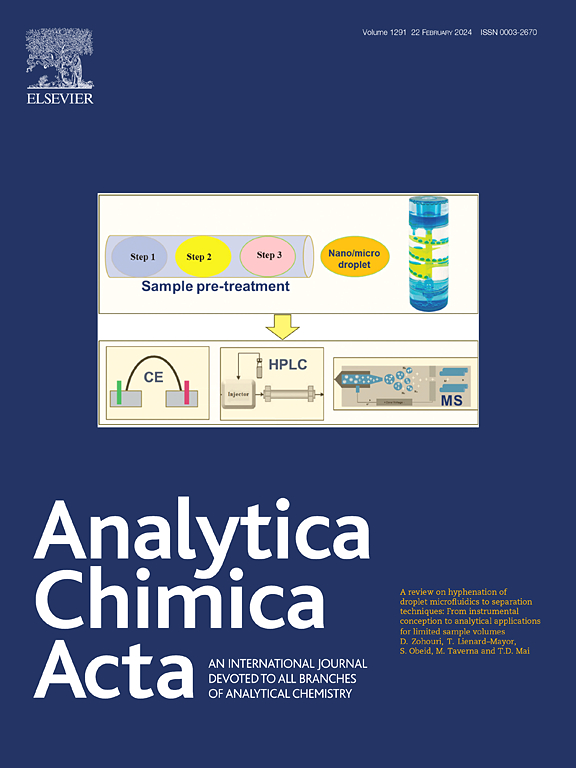人血浆和小鼠肌肉组织中酰基肉碱的全自动、高通量电萃取和分析工作流程
IF 5.7
2区 化学
Q1 CHEMISTRY, ANALYTICAL
引用次数: 0
摘要
样品制备的劳动密集型和耗时性质对生物分析提出了重大挑战,特别是对于具有有限体积/质量和低分析物丰度特征的大规模样品。此外,手工样品处理会影响再现性。为了克服这些限制,自动化和高通量方法是必不可少的,突出了对自动化,高通量样品制备和分析工作流程的需求。结果本研究建立了一个全自动、高通量电萃取(EE)平台,该平台集成了CTC PAL3自动进样器和液相色谱-质谱分析仪。对集成平台进行了验证,然后采用实验设计方法对EE参数进行了优化。选取10种酰基肉碱作为模型分析物。优化模型具有较强的拟合性(p<0.006, R2>0.91)。优化后的平台在设计的学术样品中获得了高达400的富集因子(提取回收率高达99%),并在20 μL加标的人血浆样品中有效地实施和评估。为了检验临床相关材料,利用该平台研究了肌肉组织分离速度对酰基肉碱稳定性的影响,并检测了早衰(肌肉减少症)小鼠肌肉中不同肌肉类型的酰基肉碱丰度。我们发现肌肉分离的速度不影响测量到的酰基肉碱水平,检测到的较高的酰基肉碱丰度与文献一致。这项研究提供了一个自动化的、高通量的、具有成本效益的工作流程,每天可以提取和分析120个样品,每个样品的成本为0.1欧元。在可预见的未来,它将为涉及生物质有限样本的大规模研究创造全自动、高通量的生物分析工作流程,这是一个重要的进步。本文章由计算机程序翻译,如有差异,请以英文原文为准。

A fully automated, high-throughput electro-extraction and analysis workflow for acylcarnitines in human plasma and mouse muscle tissues
Background
The labor-intensive and time-consuming nature of sample preparation poses significant challenges for bioanalysis, especially for large-scale samples characterized by limited volumes/mass, and low analyte abundance. Additionally, manual sample processing can compromise reproducibility. To overcome these limitations, automation and high-throughput methodologies are essential, highlighting the need for an automated, high-throughput sample preparation and analysis workflow.
Results
This study presents a fully automated, high-throughput electro-extraction (EE) platform integrated with a CTC PAL3 autosampler and liquid chromatography–mass spectrometry analyzer. The integrated platform underwent qualification, followed by optimization of EE parameters using a Design of Experiment approach. Ten acylcarnitines were selected as model analytes. The optimization models exhibited strong fits (p < 0.006, R2 > 0.91). The optimized platform achieved an enrichment factor of up to 400 (an extraction recovery of up to 99 %) in designed academic samples, and was effectively implemented and evaluated using 20 μL of spiked human plasma samples. To test clinically relevant materials, the platform was utilized to study the effects of muscle tissue isolation speed on acylcarnitine stability, and to examine acylcarnitine abundance across muscle types in progeria (sarcopenia) mouse muscle. We found that the speed of muscle isolation does not affect measured levels of acylcarnitines, and detected higher acylcarnitine abundances are consistent with literature.
Significance
This study provides an automated, high-throughput, and cost-effective workflow enabling extraction and analysis of 120 samples per day, with a cost of <0.1 Euro per sample. It presents a significant stride towards the creation of fully-automated, high-throughput bioanalysis workflows for large-scale studies involving biomass limited samples in the foreseeable future.
求助全文
通过发布文献求助,成功后即可免费获取论文全文。
去求助
来源期刊

Analytica Chimica Acta
化学-分析化学
CiteScore
10.40
自引率
6.50%
发文量
1081
审稿时长
38 days
期刊介绍:
Analytica Chimica Acta has an open access mirror journal Analytica Chimica Acta: X, sharing the same aims and scope, editorial team, submission system and rigorous peer review.
Analytica Chimica Acta provides a forum for the rapid publication of original research, and critical, comprehensive reviews dealing with all aspects of fundamental and applied modern analytical chemistry. The journal welcomes the submission of research papers which report studies concerning the development of new and significant analytical methodologies. In determining the suitability of submitted articles for publication, particular scrutiny will be placed on the degree of novelty and impact of the research and the extent to which it adds to the existing body of knowledge in analytical chemistry.
 求助内容:
求助内容: 应助结果提醒方式:
应助结果提醒方式:


